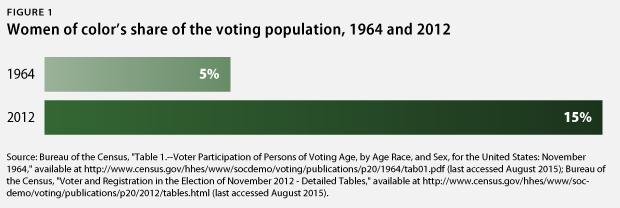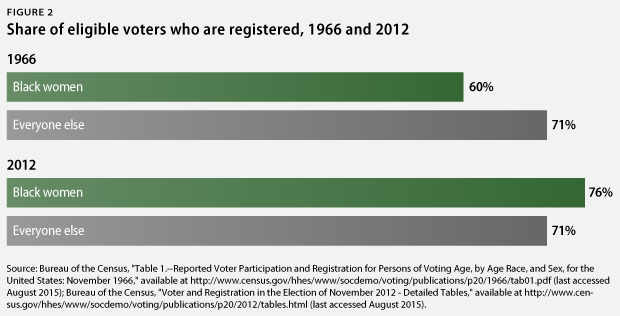This charticle contains a correction.
Over the past several years, advocates around the country have been fighting to preserve and restore one of American citizens’ most basic rights: the right to vote. Voting access is critical to fulfilling the nation’s promise of equality and ensuring that all citizens—regardless of their race, gender, or ethnicity—are able to fully participate in the democratic process. For women and people of color, the power of the vote has been instrumental in helping to expand opportunities in employment, education, and beyond and to level the playing field so that everyone has a chance to succeed.
But the right to vote is increasingly under attack. At the national level and across the country, efforts to limit who can vote, when they can vote, and where they vote have fueled highly partisan, heated debates about the potential impact of such changes on senior citizens, young people, women, people of color, and low-income communities.
Amid this ongoing conversation about how best to ensure equal voting access, there is growing evidence that one particular segment of the population—women of color—is poised to play a more decisive role in future elections. An examination of data from the U.S. Census Bureau and other sources reveals that women of color, especially African American women, are becoming a larger proportion of the electorate. Women of color’s growing influence becomes clear when comparing recent voting and registration numbers with those from the 1960s, when the Voting Rights Act and other key legislation increased ballot box access for African Americans and other people of color.
Share of voters who are women of color
In the 1964 presidential election, 1 in 20 voters was a woman of color. By the 2012 election, more than one in six voters was a woman of color.

A variety of factors have affected this change in the proportion of women of color voters, but two are particularly noteworthy. First, the Voting Rights Act of 1965 had a considerable impact on the ability of people of color—especially African Americans—to exercise the basic American right to vote. Second, American women of color made up a smaller portion of the overall population in 1964 than they do today. Women of color made up 19 percent of the overall population in 2014 and comprised 15 percent of the voting-age citizen population in 2012. In 1964, they were just 6 percent of the voting-age population and 6 percent of the overall population. (See the note below for more information.) As a result, women of color are now a larger bloc of the voting population. This growth also provides insight into the future: People of color of all genders are projected to make up approximately half of the eligible voter population in 2052.
Share of African American women who are registered to vote
Additionally, the Census Bureau’s data show that black women are especially engaged voters whose registration and voting levels have increased over time.
In 1966—registration information is not available for 1964—60 percent of African American women were registered to vote compared with 71 percent of all other eligible voters. In 2012, 76 percent of African American women were registered to vote, while the registered share of all other eligible voters remained static at 71 percent.

African American women made up nearly 7 percent of the voting-aged citizen population as of 2014. Over time, their share of registered voters has grown to a point where they are now more likely to be registered than other voters.
Share of African American women who cast votes
Likewise, in 1964, prior to the passage of the Voting Rights Act, 58 percent of African American women reported voting. In 2012, 70 percent of African American women reported voting.

Women of color cast ballots at a higher level than any other racial, ethnic, or gender group, and this pattern has persisted in presidential elections throughout the 2000s.
Conclusion
The 19th Amendment paved the way for women to vote, helping to ensure that they could enjoy the same opportunities as men to determine the nation’s direction. However, until the Voting Rights Act was enacted in 1965, many women of color, particularly in the South, were unable to enjoy the full benefits of the 19th Amendment. During this time, intentional, discriminatory barriers such as poll taxes obstructed African Americans’ access to the ballot box.
Today, the vitality of the 19th Amendment is facing new attacks. The Supreme Court’s troubling 2013 decision in Shelby County v. Holder struck down a key Voting Rights Act provision that has been a critical tool for the U.S. Department of Justice to uncover and combat discriminatory voting practices. Passage of voting rights reforms at the federal level will be essential to ensuring that all voters—regardless of their race, gender, or ethnicity—have a fair chance to participate in the electoral process.
Despite having faced significant voting hurdles throughout American history, women of color played a crucial role in the outcome of the 2012 election—particularly African American women, who exercised their right to vote at a higher rate than any other demographic group.*
Looking forward, the power of women of color voters will only continue to grow. Their ability to vote is vital to the health of our democratic society. And, in turn, elected officials must respond to the needs of this increasingly engaged and highly influential voting bloc.
Emily Baxter is a Research Associate for the Economic Policy team at the Center for American Progress. Kaitlin Holmes is a Special Assistant for the Women’s Initiative at the Center. Robert Griffin is a Senior Research Associate for Progressive Studies at the Center.
Note: It is important to remember that the data presented above do not always represent exact comparisons but rather compare similar categories. Although the Census Bureau provides the best and longest-running data available on voter registration and voting rates, the racial and ethnic categories that it records have changed considerably over time. For example, the Census Bureau did not record Hispanic or Latino ethnicity in the 1960s. For this reason, the authors chose the broadest possible definitional categories available:
- For 2012 data, the “women of color” category includes every woman who is not listed as being “white non-Hispanic alone,” using only citizen population data—that is, the total number of women minus white, non-Hispanic women. “Black women” or “African American women” refers to the data in the Census Bureau’s “black women alone or in combination” category, using only citizen population data.
- For 1960s voting data, the “women of color” category includes women listed under the Census Bureau’s “nonwhite” category. “Black women” or “African American women” refers to data in the Census Bureau’s “Negro” women category.
- For 1960s population data, the “women of color” category includes every woman who is not listed as being white—that is, the total number of women minus white women.
The authors believe the comparisons are still valid because estimates of the Hispanic/Latino population in the United States during the 1960s were quite small—about 3 percent of the total American population. The share of that population that was of voting age is unclear.
Lastly, in more recent years, the Census Bureau has also distinguished the total American voting-age population from the total citizen—or vote-eligible—population. In the past, the Census Bureau only provided the entire population of voting age.
* Correction, August 26, 2015: This charticle has been corrected to accurately reflect that African American women voted at higher rates than any other demographic group in the 2012 election.